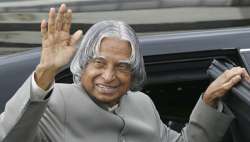Abdul Kalam wanted to witness Mangalyaan Launch, reveals book
The quite adored former President A P J Abdul Kalam had to leave Bengaluru a day prior Mangalyaan mission's dispatch on September 24, 2014 with "childlike reluctance" as he needed to address a university convocation,

The quite adored former President A P J Abdul Kalam had to leave Bengaluru a day prior Mangalyaan mission's dispatch on September 24, 2014 with "childlike reluctance" as he needed to address a university convocation, says the then ISRO boss K Radhakrishnan in his journal.
"On 23 September, a day before the D-day, we had a very pleasant surprise - Kalam Sir decided to take a detour from his Chennai-Delhi trip and join us at Bengaluru. He spent a couple of hours at ISTRAC, greeted everyone present there and listened to a briefing by mission director Kesava Raju at MOX," says Dr Radhakrishnan in "My Odyssey: Memoirs of the Man behind the Mangalyaan Mission".
"Kalam Sir, our first mission director of SLV-3 in 1979-80, appeared satisfied with our preparations. I could guess that he was in two minds, whether to stay back with us for the next day or honour his commitment for a convocation address at a university in north India.
"With childlike reluctance, he left for the airport to catch the last flight to Delhi but reminded me to keep him posted on the progress because he wanted to mention it during the convocation address the next afternoon," he recalls.
India scripted space history that day by successfully placing its low-cost Mars spacecraft Mars Orbiter Mission (MOM) in orbit around the red planet in its very first attempt.
Like many of his fellow space professionals, Dr Radhakrishnan, who was ISRO chief till December 2014, too was enamoured by the idea of an interplanetary probe to Mars while he was the director of Vikram Sarabhai Space Centre.
"The possibility of an Indian Mars probe had been discussed in our weekend sessions with V Adimurthy, the then associate director of VSSC, and his brilliant engineers led by RV Ramanan," he says.
"After taking over as the chief of ISRO in November 2009, I wished to pursue this with passion and professionalism.
Dr Adimurthy superannuated in May 2010, and I did not lose a minute in inviting him to the headquarters as a Satish Dhawan professor to contribute as our adviser on the interplanetary mission.
"Within three weeks of his taking over, we had a deliberation involving all centre directors of ISRO and the director of the Physical Research Laboratory at Antariksh Bhavan. We discussed the possibilities and constraints of a spacecraft mission to Mars that could just fly by the planet for a short while or be manoeuvred to orbit Mars several times (it was too premature then to even think of a lander mission to Mars)," he writes.
The consensus was attempting an orbiter probe at the earliest possible opportunity, based on the favourable earth-Mars-sun geometry, says the book, co-written by Nilanjan Routh, who works at the satellite communications and navigation programme office of ISRO headquarters, and published by Penguin Random House.
There were several constraints but everyone was clear that the first mission to Mars should primarily aim to establish India's technological capabilities to reach there.
Work gained momentum as by the first week of August 2010, Dr Radhakrishnan set up an interdisciplinary feasibility study team comprising 17 scientists and engineers, and Dr Adimurthy as the chairman. The study revealed feasibility to avail the next available opportunity in November 2013 for the mission.
"I had no ambiguity in choosing November 2013. It was a daunting task to fulfil, but it was worth venturing into with all the might and determination of 'team ISRO' at hand," he says.
Finally, the conch was blown when the then Prime Minister Manmohan Singh announced the Indian Mars Orbiter Mission on the 66th Independence Day in 2012. The government had approved the proposed project cost of Rs. 450 crore in total.
In a bid to get across to those who wanted to hear it, particularly youths, ISRO decided to lay stress on social media.
"We took diligent steps, followed the right mechanisms, and in less than four days between decision and implementation began to use social media through Facebook and Twitter. We created an in-house team of just three engineers to create and post content on behalf of the organization," he says.
"The response was overwhelming, even by conservative estimates. More importantly, our social media tools became a platform not only for providing quick mission updates but for serious discussions on aerospace, astronomy and the Indian space programme as a whole."
Dr Radhakrishnan also writes how he kept Prime Minister Narendra Modi periodically apprised of the preparations for the historic event and had also proposed to set up necessary technical facilities at '7RCR' for him to witness the event live and address the nation from there.
But Prime Minister Modi hinted that he "intended to be with us at Bengaluru on that morning", he says, adding that gesture "electrified the entire team and it gave me some comfort for the encounter with Mars".
He also says he made a call to Dr Singh to apprise him of the impending finish of the historical journey that he had approved two years ago as prime minister.
According to Dr Radhakrishnan, the Indian Mars Mission would probably go down as one of the most memorable feats in the history of science and technology in India.
"Not only had we succeeded in reaching the red planet on the first attempt; in the process we had developed a number of technologies that could help us better our operational space systems in the coming years. More importantly, we had instilled a belief in the country's youth that space technology was an area where we were on a par with the world's best," he says.
(With inputs from PTI)